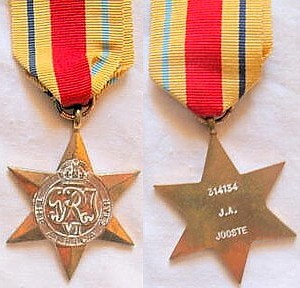Africa Star
| The Africa Star | |
|---|---|

Awarded to a South African, 314134 J.A. Jooste
|
|
| Awarded by the Monarch of the United Kingdom and the Dominions of the British Commonwealth, and Emperor of India | |
| Country |
|
| Type | Military campaign medal |
| Eligibility | All Ranks |
| Awarded for | Entry into operational service |
| Campaign | North Africa 1940–1943 |
| Clasps | NORTH AFRICA 1942–43 8th ARMY 1st ARMY |
| Statistics | |
| Established | 8 July 1943 |
| First awarded | 1943 |
| Order of wear | |
| Next (higher) | Air Crew Europe Star |
| Next (lower) | Pacific Star |
|
Ribbon bar North Africa 1942–43, 8th Army and 1st Army insignia |
|
The Africa Star is a military campaign medal, instituted by the United Kingdom on 8 July 1943 for award to subjects of the British Commonwealth who served in the Second World War, specifically in North Africa between 10 June 1940 and 12 May 1943 inclusive.
Three clasps were instituted to be worn on the medal ribbon, the North Africa 1942–43 Clasp, the 8th Army Clasp and the 1st Army Clasp.
Altogether eight campaign stars and nine clasps were initially instituted for campaign service during the Second World War. On 8 July 1943, the 1939–1945 Star and the Africa Star were the first two of these Stars to be instituted. One more campaign star, the Arctic Star, and one more clasp, the Bomber Command Clasp, were belatedly added on 26 February 2013, more than sixty-seven years after the end of the war.
Only one of these campaign stars, the 1939–1945 Star, covered the full duration of the Second World War from its outbreak on 3 September 1939 to the victory over Japan on 2 September 1945.
No-one could be awarded more than five (now six) campaign stars and no-one could be awarded more than one clasp to any one campaign star. Five of the nine (now ten) clasps were the equivalents of their namesake campaign stars and were awarded for the same respective campaigns as those stars, to be worn on the ribbon of that campaign star of the applicable group that had been earned first. The maximum of six possible campaign stars are the following:
Between 10 June 1940 and 12 May 1943 British forces fought in North Africa against the Germans and Italians, who had taken control of large areas of Egypt, Libya and Tunisia and therefore also of the Suez Canal and the sea lanes approacing it. During the desert conflict the balance of power alternated between the two sides, until the British eventually secured victory on 12 May 1943 when the remaining German forces surrendered at Tunis. Some historians consider the British victory over the German forces in North Africa to have been the turning point in the war which led to the eventual defeat of Germany.
The institution of the Africa Star was announced on 8 July 1943 and in August it was announced that the first uniform ribbons would be issued to qualifying personnel later in that year. The medals themselves were not intended to be available until after the cessation of hostilities. Some ribbon issues to overseas troops were delayed, but many had been received by the end of 1943 and were worn by recipients throughout the remainder of the war.
...
Wikipedia
